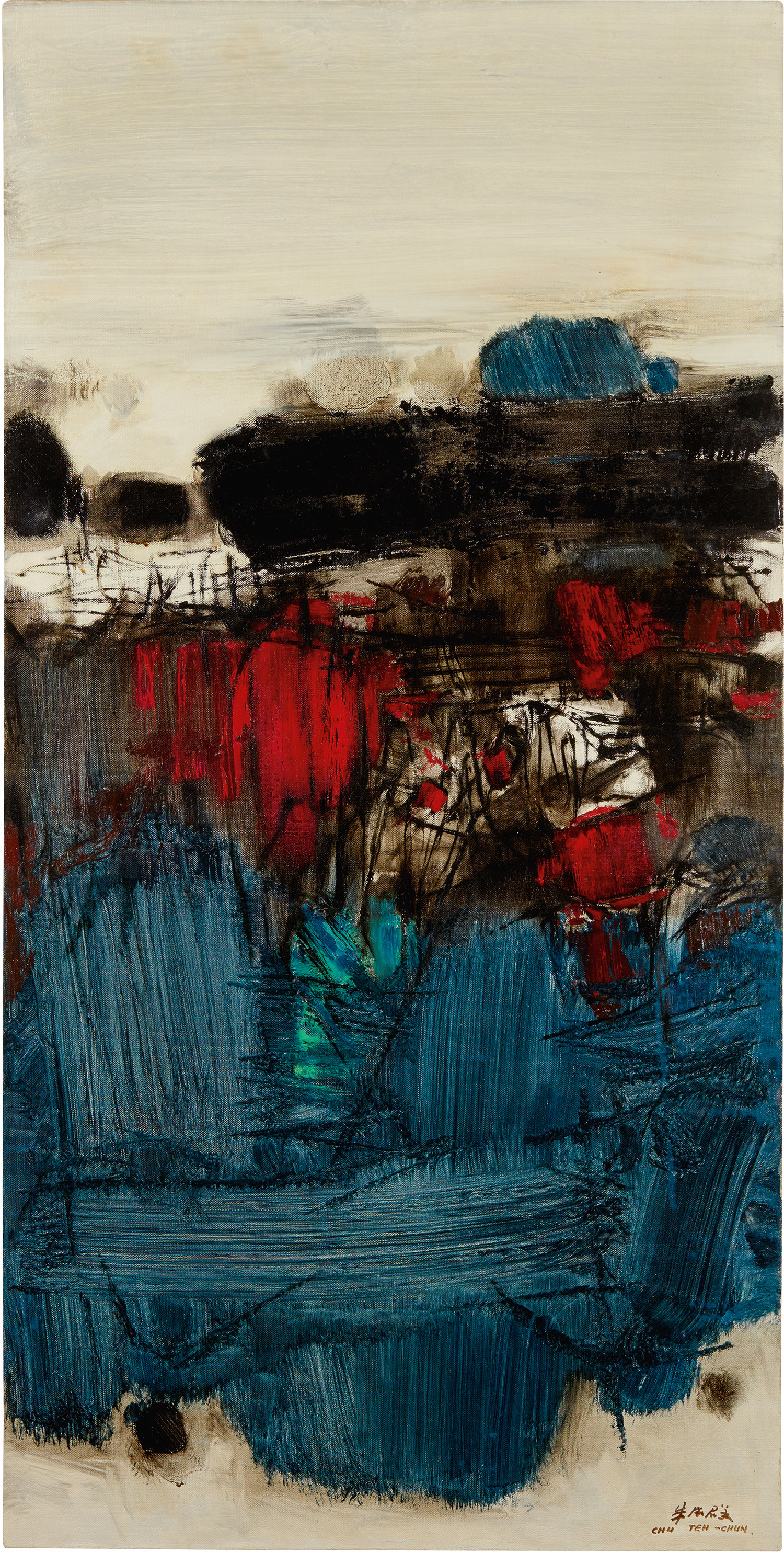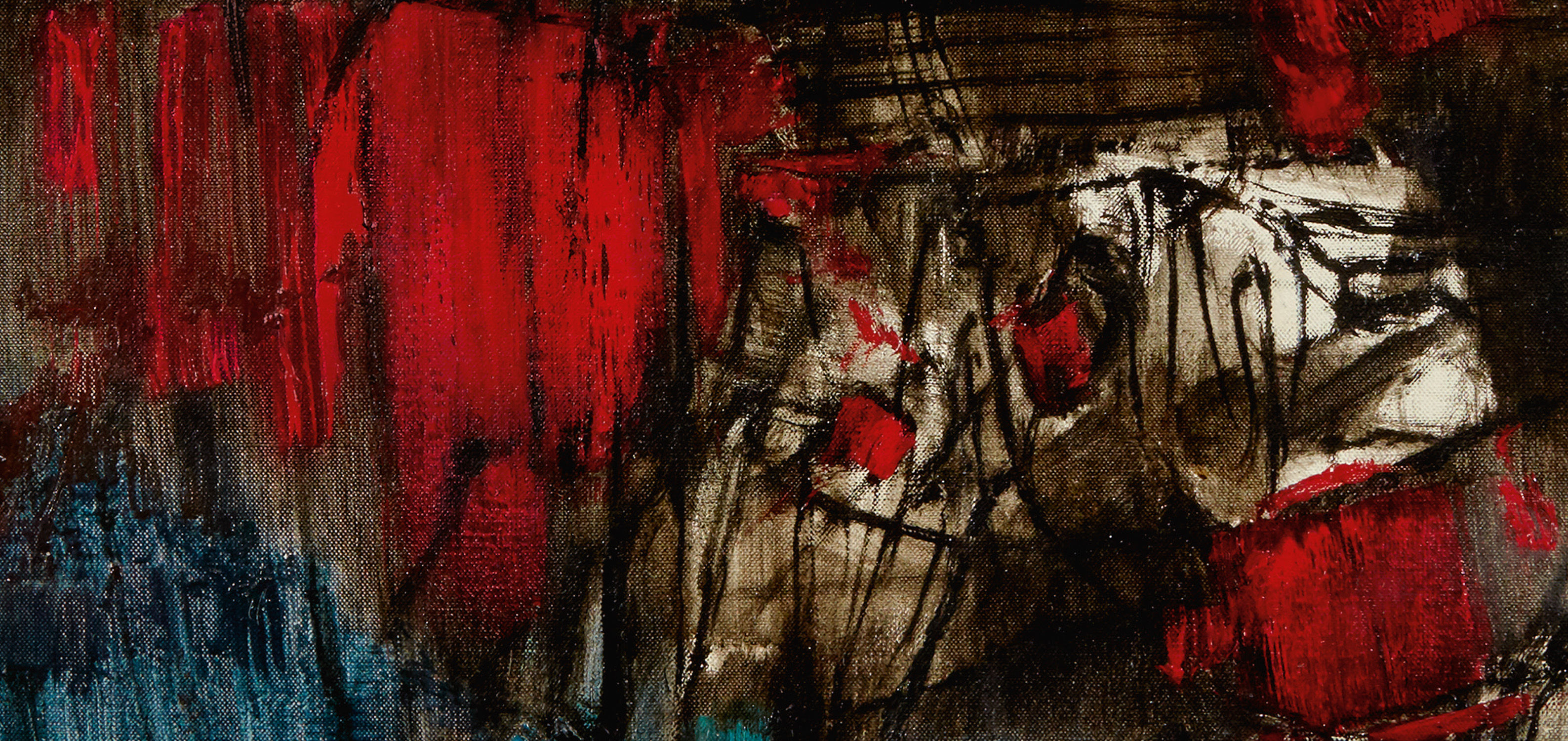



Property from an Important French Collection
13
Chu Teh-Chun
No. 164
signed 'CHU TEH-CHUN [in Chinese and Pinyin] lower right; further signed, titled and dated 'CHU TEH-CHUN [in Chinese and Pinyin] 1963 "No. 164" ' on the reverse
oil on canvas
120 x 60 cm (47 1/4 x 23 5/8 in.)
Painted in 1963, this work will be accompanied by a certificate of authenticity issued by the Fondation Chu Teh-Chun.
Full-Cataloguing
Speaking about the first retrospective of Nicolas de Stael’s work at the Musée National d’Art Moderne in 1956, Chu confided:
“It was a real revelation of the freedom of expression to me. From now on I freed myself from my twenty years of figurative work to follow my path in non-figurative painting. I slowly turned towards the inspiring thinking of traditional Chinese painting. I discovered the poetry in it and its way of observing nature which is close to Western neo-impressionist painting and particularly to abstract art. Working unconsciously on a synthesis of the two cultures, I suppressed emotion as the driving force and prolonged it through pictorial expression” (interview with Gérard Xuriguera, Les Années 50, Arted, 1984).
This statement testifies to the intense artistic stimulation which Chu Teh-Chun, an already-accomplished artist at the time, felt when he arrived in France in 1955. Post-war France was the field to an unprecedented creative era with international artists investigating abstraction in their own personal research, from texture to space, from gesture to geometry, drawing from nature to the cityscape with connections to the American action painting and the Japanese Gutai movement, a multifaceted group of artists under the banner of the “Nouvelle Ecole de Paris”, a term coined by critic Charles Estiennes in 1952. Paris acted as a catalyst for the Chinese artist who suddenly had access to the International Avant-Garde, the Louvre Museum collections, European art history and a welcome distance from his own culture: the perfect context in which to develop his new abstract style as a unique fusion of both Eastern and Western cultures.
In No. 164, Chu’s choice of colours captures his control of balance and depth in an intricate game of texture, alternating ink-like washes of deep blue and green with saturated hues of bright red outlined by solid black lines. The artist successfully diluted the oils to create the visual effect of thin ink-like washes whilst containing them to allow negative space. The unusual vertical format, with a predominantly white modulated background, further enhances the reference to scroll-mounted Chinese classical landscape paintings. With canvas as a basis and oil as his medium, Chu perfectly translates a cornerstone of Chinese tradition using the most Western form of expression, advancing a quest for the renewal of Chinese art that characterizes the golden decade of the 1960s.
1963 marked the crowning year of his collaboration with Galerie Henriette Legendre, and the artist’s third solo show. It was accompanied by a preface by Gérald Gassiot-Talabot, who wrote: “His painting flows naturally, warm and vibrant, impervious to definitions… it is a lyrical offering murmured in the secret of a serious life of meditation or bursting out noisily like a hymn, when the artist rediscovers the phrasing of great T’ang layouts.”
Chu Teh-Chun had studied calligraphy since his childhood, where his father first encouraged him to study the kuangcao (wild-cursive script) of Wang Xizhi. He then pursued the practice almost daily throughout his career, which the artist conceived as both a break from and an integral part of his painterly exploration. In No. 164 the forceful calligraphic lines create a strong compositional structure, emphasising the bold colorful brushstrokes and enhancing a feeling of dynamic movement and rhythm. In the 1960s he developed a new pictorial language merging writing, representation and abstraction in a unique painterly style, with a mastery rooted in the tradition of the arts of writing, where the ideograms and images are combined in one entity. Around the same period, German artist Hans Hartung was also investigating the dark line with recourse to calligraphy. While Hartung isolates the line on a plain background, keeping its essence as a sign intact, Chu integrates it as a key element of a complex abstract landscape-like composition in a synthesis of landscape painting and calligraphy.
In recognition of the artist’s contribution to 20th century Chinese art history, the National Museum of China in Beijing will hold a major retrospective of Chu Teh-Chun’s work in April 2020 to celebrate the centenary of the artist’s birth, followed by a second exhibition at the end of 2020 in Suzhou, the city of his birth, focusing on his works on paper.
“It was a real revelation of the freedom of expression to me. From now on I freed myself from my twenty years of figurative work to follow my path in non-figurative painting. I slowly turned towards the inspiring thinking of traditional Chinese painting. I discovered the poetry in it and its way of observing nature which is close to Western neo-impressionist painting and particularly to abstract art. Working unconsciously on a synthesis of the two cultures, I suppressed emotion as the driving force and prolonged it through pictorial expression” (interview with Gérard Xuriguera, Les Années 50, Arted, 1984).
This statement testifies to the intense artistic stimulation which Chu Teh-Chun, an already-accomplished artist at the time, felt when he arrived in France in 1955. Post-war France was the field to an unprecedented creative era with international artists investigating abstraction in their own personal research, from texture to space, from gesture to geometry, drawing from nature to the cityscape with connections to the American action painting and the Japanese Gutai movement, a multifaceted group of artists under the banner of the “Nouvelle Ecole de Paris”, a term coined by critic Charles Estiennes in 1952. Paris acted as a catalyst for the Chinese artist who suddenly had access to the International Avant-Garde, the Louvre Museum collections, European art history and a welcome distance from his own culture: the perfect context in which to develop his new abstract style as a unique fusion of both Eastern and Western cultures.
In No. 164, Chu’s choice of colours captures his control of balance and depth in an intricate game of texture, alternating ink-like washes of deep blue and green with saturated hues of bright red outlined by solid black lines. The artist successfully diluted the oils to create the visual effect of thin ink-like washes whilst containing them to allow negative space. The unusual vertical format, with a predominantly white modulated background, further enhances the reference to scroll-mounted Chinese classical landscape paintings. With canvas as a basis and oil as his medium, Chu perfectly translates a cornerstone of Chinese tradition using the most Western form of expression, advancing a quest for the renewal of Chinese art that characterizes the golden decade of the 1960s.
1963 marked the crowning year of his collaboration with Galerie Henriette Legendre, and the artist’s third solo show. It was accompanied by a preface by Gérald Gassiot-Talabot, who wrote: “His painting flows naturally, warm and vibrant, impervious to definitions… it is a lyrical offering murmured in the secret of a serious life of meditation or bursting out noisily like a hymn, when the artist rediscovers the phrasing of great T’ang layouts.”
Chu Teh-Chun had studied calligraphy since his childhood, where his father first encouraged him to study the kuangcao (wild-cursive script) of Wang Xizhi. He then pursued the practice almost daily throughout his career, which the artist conceived as both a break from and an integral part of his painterly exploration. In No. 164 the forceful calligraphic lines create a strong compositional structure, emphasising the bold colorful brushstrokes and enhancing a feeling of dynamic movement and rhythm. In the 1960s he developed a new pictorial language merging writing, representation and abstraction in a unique painterly style, with a mastery rooted in the tradition of the arts of writing, where the ideograms and images are combined in one entity. Around the same period, German artist Hans Hartung was also investigating the dark line with recourse to calligraphy. While Hartung isolates the line on a plain background, keeping its essence as a sign intact, Chu integrates it as a key element of a complex abstract landscape-like composition in a synthesis of landscape painting and calligraphy.
In recognition of the artist’s contribution to 20th century Chinese art history, the National Museum of China in Beijing will hold a major retrospective of Chu Teh-Chun’s work in April 2020 to celebrate the centenary of the artist’s birth, followed by a second exhibition at the end of 2020 in Suzhou, the city of his birth, focusing on his works on paper.